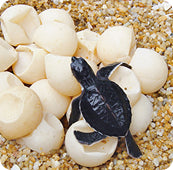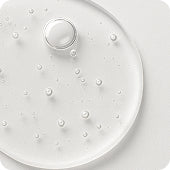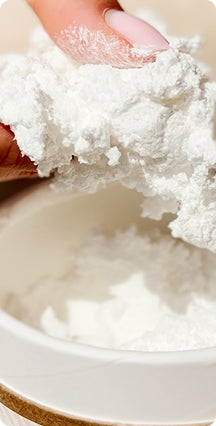Invisible plastic hazard?
Invisible plastic hazard?

When you think of plastic pollution, mountains of rubbish, dead animals and carelessly thrown away plastic packaging are bound to buzz around in your head. But plastic pollution manifests itself differently. For example, through the barely visible microplastics.
What is microplastic?
Microplastics are pieces of plastic that are smaller than five millimeters and are therefore difficult to see with the human eye.
Where does the microplastic come from?
What do chip bags, the controller of your favorite console and your functional shirt have in common? That's right, for many they are not only part of the lockdown pastime, but are also made of plastic. What we know as plastic is nothing but plastic. These are synthetically manufactured materials and are omnipresent in our everyday lives. Even if, for example, plastic bags are no longer visible to the eye after a long period of 10 - 20 years, there are tiny fragments that pollute and pollute our environment. This microplastic then gets into the organism of animals and humans.
The plastic particles that get into the seas, for example through wind and weather or through incorrect disposal, are absorbed by fish and other sea creatures in their organism. When we eat fish, the particles then get into our bodies. But we also absorb them through the air, tap water and the daily handling of plastic packaging.
We consume around 5 g of microplastics per week, which is equivalent to an entire credit card.
- There are already more than five trillion pieces of plastic floating in our seas
- It is estimated that some plastic will exist "forever".
- There have been reports of over 700 marine species eating or getting caught in plastic
How harmful is microplastic for humans?
With regard to the potential danger of microplastics, research is still in its infancy and there are large gaps in knowledge. Scientists have also disagreed for years. Some assume that the body absorbs microplastics from a size of 5 µm, but these are also excreted via the gastrointestinal tract. The nature conservation association criticizes the premature "all clear", calls for more controls of the drinking water and warns that the influence of microplastic intake through breathing has not been investigated and that the study situation is not meaningful enough.
It is clear that microplastics cost a number of animal lives every year. Marine studies have revealed that persistent pollutants tend to stick to microplastics. Thus, the pollutant content of the microplastic particle can be up to 1 million times higher than that of the surrounding water. It has been proven that microplastic particles can lead to inflammation in mussels. In animal organisms, the particles can lead not only to inflammation but also to intestinal blockages, injuries to the mucous membranes and disturbances in the hormonal balance.
The role of hormonal toxins
Additional substances are added to plastics during production. These include so-called hormone toxins (endocrine disruptors), which are similar to natural hormones and can therefore have a negative impact on hormone balance. Some endocrine disruptors are therefore banned or have strict limits. Bisphenol A (BPA) is probably one of the best-known hormone toxins. BPA can promote diseases, especially in newborns, children, the elderly and pregnant women. In laboratory mice, it was discovered in 1998 that after eating dissolved bisphenol A, the prostate enlarged, puberty started earlier and sperm quality decreased.
Microplastic promotes cancer
...because plastics attract and bind toxins. We're exposed to plastics throughout the day, and the more of them we eat, the more toxins can become stored in the body, causing inflammation. Hormone toxins are considered to be a co-trigger of hormone-related cancers, such as breast cancer and testicular cancer, infertility, diabetes, as well as obesity, immune deficiency and learning and behavioral disorders (including ADHD).
An overview study by the World Health Organization (WHO) shows the connections between the increase in hormone-related diseases and hormonal pollutants.
The largest sources of microplastics
In Germany, the abrasion of car tires is considered the largest source of microplastics. The particles, which initially remain on the road surface, can be washed into soils by rain, directly into surface water or the sewage system.
A big problem is artificial turf or the plastic granulate that is used for it. These granules are carried into the environment by the wind and by athletes.
Synthetic clothing also contributes to microplastics entering the environment. Synthetic fibers are removed during washing and end up in the waste water.
The cosmetics industry is a major source of microplastics. Plastics are not only used as abrasives in peelings and shower gels, for example, but also as film formers, emulsion and binding agents. In our 3in1 Lime Shower Fluff, for example, we use the finest sea salt particles instead of synthetic abrasives to make the skin feel smooth.
Better safe than sorry
Exactly how harmful microplastics are for the human organism has not yet been conclusively clarified and a number of studies are still required. What is certain, however, is that microplastics are very harmful to wildlife and pollute the environment.
Since microplastics can only be filtered in local sewage treatment plants to a limited extent and thus pollute the world, all our products are 100% free of microplastics, even the packaging! :-)
You can find our blog post on microplastics in cosmetics here .Our tip
Maybe replace two or three plastic products with (micro)plastic-free or even unpackaged ones. For example toothpaste or the drinking bottle. Not everyone can do everything perfectly, but everyone can change something.If you would like to be informed directly about the latest blog posts, please follow us Instagram ! :-)











